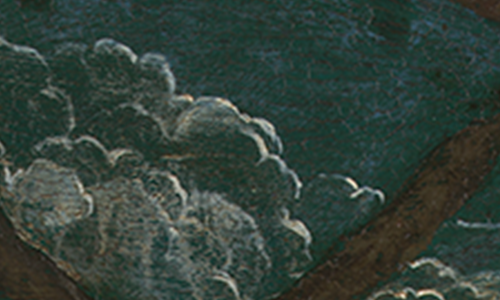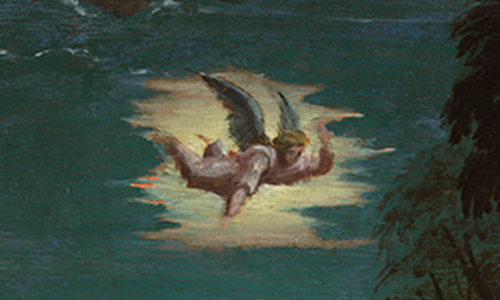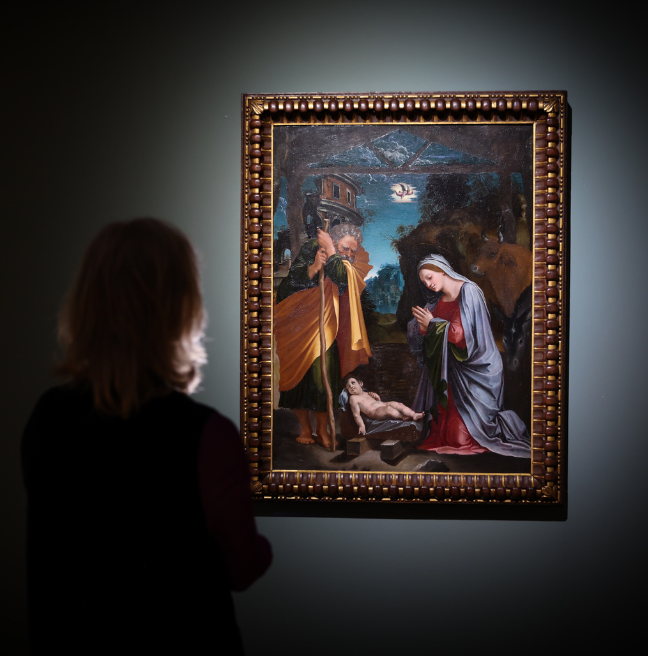
The Gift of Renaissance
The Nativity, painted in Rome around 1515, is an exceedingly rare surviving work on panel by Baldassare Peruzzi, one of the leading figures in Rome in the first decades of the sixteenth century.
High Renaissance
The Nativity was painted around 1515, in Rome, during a brief and intensely creative period of supreme confidence and experimentation. This was the highly charged world of the High Renaissance, and in the work of Michelangelo, Raphael, Peruzzi and their circle many of the rules of modern western art were formulated and also challenged, and broken.
Much of the energy, innovation and clarity of purpose associated with the High Renaissance is to be found in this small, intimate yet highly revolutionary painting. The message of the Nativity is simple, the scene is shrouded in inky darkness and the stable roof above the holy family is decrepit and broken. In the background, a remarkable architectural structure suggests the symmetry and power of the ancient world. The classical building, however, is in ruins and the birth of Christ, offers the promise of salvation.

What makes the painting remarkable is the manner in which Peruzzi has chosen to present the scene. He employs many of the innovations and discoveries of the High Renaissance in Rome, which was one of the most important movements in the history of art, and one in which he played a major role.
Nocturnal Setting
Peruzzi’s choice of a nocturnal setting for the Nativity is most striking. Night-time scenes were a characteristic device of this decade and there are two major precedents in fresco: Michelangelo’s Judith and Holofernes lunette of 1512 in the Sistine Chapel Ceiling and shortly afterwards, and in direct competition with Michelangelo, Raphael’s Liberation of St Peter of 1514 in the Stanza dei Eliodoro in the Vatican.
Peruzzi’s Nativity was painted around 1515, during the brief and intensely creative period of the High Renaissance when he was the leading painter in Rome after Michelangelo and Raphael. Peruzzi’s innovations in architecture, painting and theatre design during this period were highly original, as they combined earlier Renaissance ideas with the imaginative and experimental style of Raphael and his circle. And yet, even though Peruzzi was admired for his explorations of composition and tonality and the dramatic possibilities of his night-scenes, nonetheless in the Nativity his use of dark tonalities for a work on this intimate scale was unusual, even daring. The Nativity thus exemplifies a significant moment of change in High Renaissance Roman painting, when nocturnal settings, monumentality and antique architecture made for arresting, yet intimate paintings.
Light
What is particularly unusual, and strikingly original, in the Nativity is Peruzzi’s complex use of several light sources to illuminate the painting. The alterations in colour, intensity and focus of the light are extremely subtle, and suggest a connection with Peruzzi’s work for Renaissance theatre design.
The Nativity takes place just at the moment when dawn is beginning to illuminate the night sky. The approaching dawn, and the silvery light of the moon, which is outside the picture, appear to light the clouds above the stable roof, while it is the softer, paler moonlight, which falls on the ruined classical building and the figures of Mary, Joseph and the Christ Child.
A warmer light streams from the fiery, comet-like angel, which appears in the sky to announce the birth to the shepherds and finally the Christ Child emanates a diffused light, which further illuminates the Holy Family. The complexity of these light sources can be traced though the different shadows which are cast, particularly by the blocks of masonry, which support the Christ Child’s cradle.




